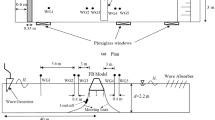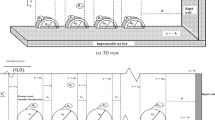Abstract
A novel concept of a hybrid floating breakwater-windbreak structure is proposed to shield vulnerable coastal regions from both extreme wave and wind loads in storms. A porous design was adopted for the breakwater part of the structure with the view to improving its hydrodynamic performance. The porosity was achieved by having horizontal internal water channels in the breakwater for free passage of water through the breakwater body. The wave response of such a floating structure is first investigated by analytical solution and then partially compared with laboratory model tests. A CFD analysis was performed to investigate the sidewall effects in the model tests. The horizontal wave forces and wave elevations in the vicinity of the floating breakwater with and without internal water channels were measured experimentally and compared so as to assess the effect of the water channels. The results show that the water channels help to reduce the lateral wave excitation force which is advantageous to breakwaters held in position by mooring dolphins/caissons. At the same time, the floating breakwater efficiency was maintained since the porosity did not increase in the wave transmission coefficient.





























Similar content being viewed by others
References
Ansys Fluent, 12.0 (2009) User's and theory guide. Canonsburg, Pennsylvania, USA: ANSYS, Inc.
Arnaud G, Rey V, Touboul J, Sous D, Molin B, Gouaud F (2017) Wave propagation through dense vertical cylinder arrays : interference process and specific surface effects on damping. Appl Ocean Res 65:229–237
Ashlin SJ, Sannasiraj SA, Sundar V (2018) Performance of an array of oscillating water column devices integrated with an offshore detached breakwater. Ocean Eng 163:518–532
Behera H, Khan MB (2019) Numerical modeling for wave attenuation in double trapezoidal porous structures. Ocean Eng 184:91–106
Celli D, Li Y, Ong MC, Di Risio M (2019) The role of submerged berms on the momentary liquefaction around conventional rubble mound breakwaters. Appl Ocean Res 85:1–11
Ciocan CS, Taveira-Pinto F, das Neves L, Rosa-Santos P (2017) Experimental study of the hydraulic efficiency of a novel perforated-wall caisson concept, the LOWREB. Coast Eng 126:69–80
Di Lauro E, Lara JL, Maza M, Losada IJ, Contestabile P, Vicinanza D (2019) Stability analysis of a non-conventional breakwater for wave energy conversion. Coast Eng 145:36–52
Evans DV (1978) The oscillating water column wave-energy device. IMA J Appl Math 22(4):423–433
Fang Z, Xiao L, Kou Y, Li J (2018) Experimental study of the wave-dissipating performance of a four-layer horizontal porous-plate breakwater. Ocean Eng 151:222–233
Gu Z, Wang H (1991) Gravity waves over porous bottoms. Coast Eng 15(5–6):497–524
Huang Z, Li Y, Liu Y (2011) Hydraulic performance and wave loadings of perforated/slotted coastal structures: a review. Ocean Eng 38(10):1031–1053
Ji CH, Suh KD (2010) Wave interactions with multiple-row curtainwall-pile breakwaters. Coast Eng 57(5):500–512
Kanoria M, Dolai DP, Mandal BN (1999) Water-wave scattering by thick vertical barriers. J Eng Math 38:361–384
Kolahdoozan M, Bali M, Rezaee M, Moeini MH (2017) Wave-transmission prediction of π-type floating breakwaters in intermediate waters. J Coastal Res 33(6):1460–1466
Koley S, Sahoo T (2017) Wave interaction with a submerged semicircular porous breakwater placed on a porous seabed. Eng Anal Boundary Elem 80:18–37
Koraim AS, Heikal EM, Zaid AA (2014) Hydrodynamic characteristics of porous seawall protected by submerged breakwater. Appl Ocean Res 46:1–14
Laju K, Sundar V, Sundaravadivelu R (2011) Hydrodynamic characteristics of pile supported skirt breakwater models. Appl Ocean Res 33(1):12–22
Liu Y, Li HJ, Li YC (2012) A new analytical solution for wave scattering by a submerged horizontal porous plate with finite thickness. Ocean Eng 42:83–92
Liu Y, Li HJ (2017) Iterative multi-domain BEM solution for water wave reflection by perforated caisson breakwaters. Eng Anal Boundary Elem 77:70–80
Linton C, McIver P (2001) Mathematical techniques for wave/structure interactions. CRC Press, Boca Raton
Loukogeorgaki E, Yagci O, Kabdasli MS (2014) 3D Experimental investigation of the structural response and the effectiveness of a moored floating breakwater with flexibly connected modules. Coast Eng 91:164–180
Martin-Medina M, Abadie S, Mokrani C, Morichon D (2018) Numerical simulation of flip-through impacts of variable steepness on a vertical breakwater. Appl Ocean Res 75:117–131
Meylan MH, Bennetts LG, Peter MA (2017) Water-wave scattering and energy dissipation by a floating porous elastic plate in three dimensions. Wave Motion 70:240–250
Schmitt P, Elsäßer B (2017) The application of Froude scaling to model tests of Oscillating Wave Surge Converters. Ocean Eng 141:108–115
Somervell LT, Thampi SG, Shashikala AP (2018) Estimation of friction coefficient for double walled permeable vertical breakwater. Ocean Eng 156:25–37
Teh HM, Venugopal V, Bruce T (2013) Performance enhancement of a perforated free surface semicircular breakwater. In: The Twenty-third international offshore and polar engineering conference. International Society of Offshore and Polar Engineers, Anchorage, Alaska
Tofany N, Ahmad MF, Mamat M, Mohd-Lokman H (2016) The effects of wave activity on overtopping and scouring on a vertical breakwater. Ocean Eng 116:295–311
Twu SW, Chieu CC (2000) A highly wave dissipation offshore breakwater. Ocean Eng 27(3):315–330
Ulker MC, Tatlioglu E, Lav MA (2018) Dynamic response and liquefaction analysis of seabed-rubble mound breakwater system under waves. Appl Ocean Res 78:75–87
Verduzco-Zapata MG, Ocampo-Torres FJ, Mendoza E, Silva R, Liñán-Cabello M, Torres-Orozco E (2017) Optimal submergence of horizontal plates for maximum wave energy dissipation. Ocean Eng 142:78–86
Wang CM, Han MM, Lyu J, Duan WH, Jung KH, Kang An S (2020) Floating forest: a novel concept of floating breakwater-windbreak structure. In: Wang C, Lim S, Tay Z (eds) WCFS2019. Lecture notes in civil engineering, vol 41. Springer, Singapore. https://doi.org/10.1007/978-981-13-8743-2_12
Wen H, Ren B, Wang G (2018) 3D SPH porous flow model for wave interaction with permeable structures. Appl Ocean Res 75:223–233
Xiao L, Kou Y, Tao L, Yang L (2016) Comparative study of hydrodynamic performances of breakwaters with double-layered perforated walls attached to ring-shaped very large floating structures. Ocean Eng 111:279–291
Zhang SX, Li X (2014) Design formulas of transmission coefficients for permeable breakwaters. Water Sci Eng 7(4):457–467
Zheng YH, You YG, Shen YM (2004) On the radiation and diffraction of water waves by a rectangular buoy. Ocean Eng 31(8–9):1063–1082
Acknowledgements
The authors are grateful to the Australian Research Council for providing the Discovery Project DP170104546 grant, as well as to Hyundai Engineering and Construction and the ARC NanoCOMM Hub for additional grants to perform this study.
Author information
Authors and Affiliations
Corresponding author
Additional information
Publisher's Note
Springer Nature remains neutral with regard to jurisdictional claims in published maps and institutional affiliations.
Rights and permissions
About this article
Cite this article
Han, M.M., Wang, C.M. Hydrodynamics study on rectangular porous breakwater with horizontal internal water channels. J. Ocean Eng. Mar. Energy 6, 377–398 (2020). https://doi.org/10.1007/s40722-020-00178-4
Received:
Accepted:
Published:
Issue Date:
DOI: https://doi.org/10.1007/s40722-020-00178-4




